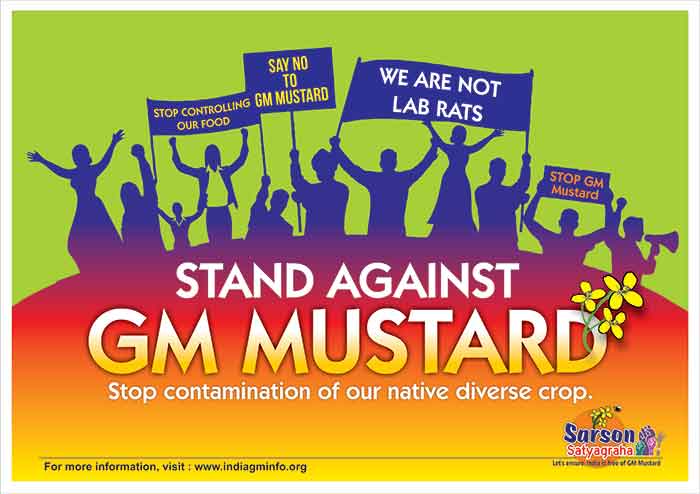
The extremely serious issue of the threat of genetic contamination caused by genetically modified or engineered (GM or GE) crops finally reached the Supreme Court of India on November 30 in the context of on-going cases relating to the introduction of GM Mustard in India. Advocate Prashant Bhushan, after pointing out the serious implications of this risk in a country where high bio-diversity of mustard exists, pleaded that to avoid genetic contamination, the GM mustard plants already planted should be uprooted.
It was important to raise this issue in court as in the recent debate on GM crops, one factor that has not received adequate attention is that due to the threat of contamination, it is difficult for normal crops or organic crops to remain free from the impact of GM crops once these have been released. As worldwide concern for food safety grows, it is likely that there will be increasing demand for organically grown crops and crops which are not contaminated by GM crops. Therefore we will be surrendering premium world markets if we allow our crops to be contaminated. This is why organizations like those of rice exporters have also got involved in the campaigns against GM crops. Star Link (corn engineered to contain a Bt toxin pesticide) was planted on less than 0.5% of US corn crop area, but its recall cost hundreds of millions of dollars, and even then the recall was not entirely successful.
Several eminent scientists representing the Independent Science Panel have also warned against the serious threat of contamination by GM crops – “Extensive transgenic contamination has occurred in maize landraces growing in remote regions in Mexico despite an official moratorium that has been in place since 1998. High levels of contamination have since been found in Canada. In a test of 33 samples of certified canola (oilseed rape) seed stocks, 32 were found contaminated. New research shows that transgenic pollen, wind-blown and deposited elsewhere, or fallen directly to the ground, is a major source of transgenic contamination. Contamination is generally acknowledged to be unavoidable, hence there can be no co-existence of transgenic and non-transgenic crops.”
“Crops engineered with ‘suicide’ genes for male sterility have been promoted as a means of ‘containing’, i.e., preventing, the spread of transgenes. In reality, the hybrid crops sold to farmers spread both male sterile suicide genes as well herbicide tolerance genes via pollen.”
It is due to the serious threat of contamination that even trials of GM crops are considered unacceptably risky.
Eminent scientist Prof. Pushpa M. Bhargava, founder of the Centre for Cellular and Molecular Biology, had explained this threat in the context of Bt brinjal, and this is also relevant in the present context—“Eighty four percent of our farmer community consists of small and marginal farmers with a holding of less than four hectares land. According to Monsanto data, Bt brinjal pollen can travel for 30 meters and could thus easily contaminate the neighboring non-Bt brinjal field. In course of time we would be left with no non-Bt yield even if the farmers do not want the transgenic crop.” In this way, the distinguished scientist went on to explain, farmers will lose the market of all health-conscious, safety conscious consumers, at home and abroad.
Prominent environmentalist Sailendra Nath Ghosh has written, – “In view of the virtual impossibility of preventing contamination, even the open-field trials ought not to be permitted. According to independent geneticists, the isolation distance needed to be both in time and space. The land on which the GM crop is to be grown should not sow a crop in the previous or the succeeding year. Cross-pollinating crops, unlike the self-pollinating ones, require isolation distance of three to four kms. The implementation of these requirements is impossible under Indian conditions. Farmers would not keep their lands fallow. Crops in adjoining fields are almost always planted up to the boundaries. The trials needed to be in greenhouses controlled by independent institutions.”
Several of these threats were examined at an international conference of scientists involved in studying the implication and impacts of genetic engineering. This conference on ‘Redefining the Life Sciences’ was organized at Penang, Malaysia, by the Third World Network. These scientists and experts issued a statement called the Penang Statement (PS).
This statement listed a wide range of potential adverse effects of genetic engineering. Of particular concern is the difficulty or impossibility of recalling GEOs ( genetically engineered organisms or GMOs ) which have been released into the environment, or which have escaped from containment and later found to have adverse effects.
The potential ecological risks of applying genetic engineering to agriculture include the possibility that some transgenic crops could become noxious weeds, and others could become a conduit through which new genes may move to wild plants which themselves could then become weeds. The new weeds could adversely affect farm crops as well as wild ecosystems. Similarly, genetically engineered fish, shellfish and insects could become pests under certain conditions.
Plants are presently being engineered to contain parts of a virus in order to become virus-resistant. Some scientists have raised the possibility that widespread use of transgenic virus-resistant plants in agriculture may lead to new strains of viruses or allow a virus to infect a new host. There are concerns that the creation of new viral strains and the broadening of the virus’s host may increase the risks of new viral diseases that adversely affect crops and other plants. Mechanisms have been described whereby genetically engineered plants could plausibly give rise to new plant diseases.
In addition this statement warns that the rapid spread of transgenic crops poses a threat to traditional crop varieties and wild plants that are the major sources of crop genetic diversity.
Some traits of organisms may take decades or even longer to manifest themselves. An organism declared ‘safe’ in the short term could eventually prove to be dangerous.
Another ecological risk is the possibility that field or forestry plants engineered to express toxic substances like pesticides and pharmaceutical drugs may poison certain non-target organisms. Transgenes for insecticidal or fungicidal compounds that are introduced into crops to inhibit pests may unintentionally kill non-target and beneficial insects and fungi. Transgenic crops used to manufacture drugs or industrial oils and chemicals could potentially harm animals, insects and soil microorganisms.
The possible chemical contamination of surface-water and ground-water by microorganisms or plants with unusual or accelerated metabolic processes is a special concern because of the crucial importance of water for all life. It may be impossible to recall and difficult to control harmful GEOs, especially those that may contaminate ground-water.
This statement adds that developing countries in particular face special risks : “Third World countries face even greater environmental risks than countries of the North because, in contrast, they have many wild relatives of many crops and thus there are more opportunities for various kinds of rogue species to be created.”
Moreover, most Third World countries currently have less scientific expertise and legal or regulatory capacity to monitor, assess and control activities involving genetically engineered organisms, and are thus even more vulnerable to adverse impacts.
This issue should also be examined in the context of what has been called the ‘terminator technology’. In widely discussed paper (published in the Ecologist, Sept/Oct 1998) Ricarda A Steinbrecker (Science Director of the Genetics Forum UK) and Pat Roy Mooney (widely acclaimed winner of the Right to Livelihood Award) summarized the implications of this most controversial use of generic engineering,
“On March 3rd 1998 the US Department of Agriculture (USDA) and a little-known cotton-seed enterprise called Delta and Pine Land Company, acquired US patent 5,723,765 – or the Technology Protection System (TPS). Within days, the rest of the world knew TPS as Terminator Technology. Its declared goal is to promulgate plants that will produce self terminating offspring – suicide seeds. Terminator Technology epitomizes what the genetic engineering of food crops is all about and gives an insight into the driving forces behind the corporate campaign to control and own life.”
Further this paper says, “Most alarming through is the possibility that the Terminator genes themselves could infect the agricultural gene pool of the neighbor’s crops and of wild and weedy relatives, placing a time bomb. Temporary “gene silencing” of the poison gene or failed activation of the Terminator countdown enables such infection.”
Clearly the threat from GM crops to natural farming systems and environment is so serious that we need to be very cautious. Unfortunately, as has been exposed already in the context of Bt cotton repeatedly, the tendency of official policy, under the pressures of the powerful GM lobby, has been to think of safety later (if at all) and haste in introduction first. This explains why when sheep started dying after grazing in Bt cotton fields and dairy animals too experienced many highly distressing adverse effects after consuming Bt cotton oilcake, inquiries revealed that essential research and tests needed in this context were still to be carried out. In the absence of efforts to find out any relationships and impacts, we have no means of knowing the adverse impacts of huge consumption of cottonseed oilcake by dairy animals as confirmed by official research (even though independent research has established the likelihood of highly adverse impacts), or adverse impact on the health of human beings who consume the milk of these animals, or adverse impact of rampant use of cottonseed oil for preparing human food particularly in the form of snack food sold commonly in the market. Why are governments prepared to endanger the health of people and farm animals when they should be guided by the precautionary principle? In the case of GM mustard the risks are much higher as this is entirely a food and medicinal crop—not just its oil and oilcakes but even its leaves are widely used to prepare a much relished green leafy preparation and it is put to several medicinal uses. With the government system entirely in the grip of the GM lobby, the only hope is now from the judiciary (the good news has just come in that the high court in Kenya has checked the recent decision of the government there to open up the country to GM food), the farmers’ movement and other people’s movements opposing the onslaught of GM crops and food in India.
Bharat Dogra is Honorary Convener, Campaign to Save Earth Now. His recent books include ‘Planet in Peril’, ‘India’s Quest for Sustainable Farming and Healthy Food’ and ‘14 Crucial Questions about GM Crops’.














































